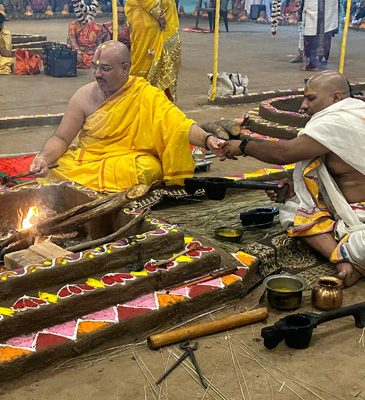There are seven distinct Soma Yagna rituals (with many more variants within these), each representing a progressive stage in the Vedic tradition of offering the sacred Soma to the divine. These rituals reflect the spiritual depth, discipline, and harmony between humanity, nature, and the cosmos.
The RigVedic description of Soma Yagna covers action and ideology, the process of offering the juice from the Soma plant to Gods through Agni, the messenger in Yajnas. The literary source for understanding Soma Yagna is the RigVeda and the archaeological proofs are seen in the various seals and figurines of Indus / Harappan civilization dating back over 2,000 years.
A brief introduction to the seven types of Soma Yagna:
Agniṣṭoma – The foundational offering
Known as the model for all Soma sacrifices, this one-day ritual involves pressing the Soma juice three times — at dawn, midday, and evening — and offering it to Agni and other deities. It symbolises purity, prosperity, and balance in nature. In modern practice, symbolic substitutes replace any animal offerings, reflecting compassion and contemporary ethics of non-violence.
Atyagniṣṭoma – The extended rite
This variation expands upon the Agniṣṭoma, adding extra Soma libations and chants. The ritual represents an intensified spiritual aspiration, deepening the connection between the devotee and the divine forces that sustain life.
Uktya (Ukthya) – The mantra-based offering
Derived from the Sanskrit word ukta (praise), this ritual emphasizes devotional mantra addressed particularly to Indra and other gods. The additional verses celebrate divine strength, courage, and gratitude, reinforcing the power of sacred sound.
Ṣoḍaśī (Shodashi) – The sixteen-fold offering
A more elaborate version of the previous rites, the Ṣoḍaśī incorporates sixteen distinct Vedic chants and offerings, symbolising completeness and spiritual perfection. It reflects the belief that the universe is sustained through harmony and precise order.
Atirātra – The overnight sacrifice
Meaning “beyond the night,” this ritual extends through the evening into dawn. Continuous offerings of Soma during the night represent the victory of light and knowledge over darkness and ignorance, linking the human spirit to cosmic renewal.
Āptoryāma (Aptoryama) – The rite of fulfilment
This is a very comprehensive version of the Soma Yagna, combining features of earlier rituals with additional offerings and chants. It is performed to attain spiritual fulfilment, prosperity, and harmony, marking the culmination of the Soma tradition.
Vājapeya – The drink of strength
The grandest of all Soma rituals, Vājapeya symbolises royal energy, abundance, and peace. It spans several days and includes seventeen Vedic mantras, offerings, and a ceremonial chariot race, representing speed, victory, and the movement of the cosmos. The ritual concludes with acts of charity and community sharing, affirming the Vedic principle of universal welfare.
Together, these yagnas form a continuum of sacred practice that celebrates life, balance, and the unity of all existence. They remind us that true wellbeing arises when humanity lives in harmony with nature and divine order.
In honouring the Soma Yagna, we not only preserve an ancient Vedic tradition but also reaffirm our collective responsibility toward peace, sustainability, and spiritual awakening.
